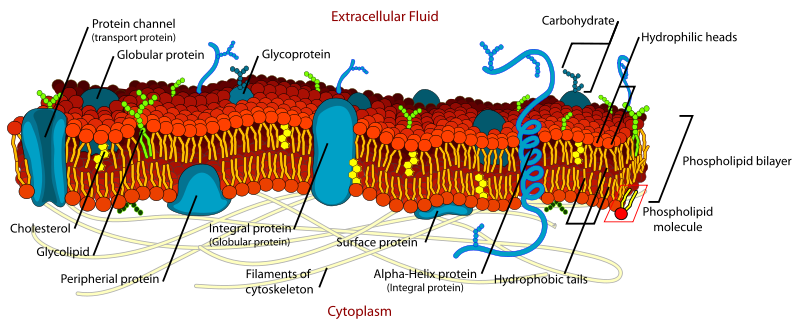Membrane protein: Difference between revisions
mNo edit summary |
No changes. Page could do with more links and a ref or two. |
||
| Line 1: | Line 1: | ||
[[Image:Membrane Protein.png|frame|right|800px | [[Image:Membrane Protein.png|frame|right|800px]]Membrane [[Proteins|proteins]] are proteins situated at the [[Lipid bilayer|lipid bilayer]] or membrane of the cell. In animal cells, these proteins make up around 50% of the mass of the plasma membrane. Different types of membrane proteins are present at the membrane and each has different structure. They also carry out different functions. These functions are vital to the cell. Membrane protein acts as transporters, anchors, receptors and lastly [[Enzyme|enzymes]]. Moreover, different types of membrane proteins associate with the lipid bilayer in different ways: transmembrane, monolayer-associated, lipid-linked and protein-attached. <br> | ||
== Functions == | == Functions == | ||
| Line 41: | Line 41: | ||
=== Protein-attached proteins === | === Protein-attached proteins === | ||
Protein-attached proteins are indirectly associated with the bilayer through other proteins which are situated within the bilayer. They are attached to the proteins through weak, noncovalent interactions. They can also be at the either side of the cell. | Protein-attached proteins are indirectly associated with the bilayer through other proteins which are situated within the bilayer. They are attached to the proteins through weak, noncovalent interactions. They can also be at the either side of the cell. | ||
<span style="border-top-left-radius: 2px; border-top-right-radius: 2px; border-bottom-right-radius: 2px; border-bottom-left-radius: 2px; text-indent: 20px; width: auto; padding: 0px 4px 0px 0px; text-align: center; font-style: normal; font-variant-caps: normal; font-weight: bold; font-size: 11px; line-height: 20px; font-family: 'Helvetica Neue', Helvetica, sans-serif; color: rgb(255, 255, 255); background-image: url(data:image/svg+xml;base64,PHN2ZyB4bWxucz0iaHR0cDovL3d3dy53My5vcmcvMjAwMC9zdmciIGhlaWdodD0iMzBweCIgd2lkdGg9IjMwcHgiIHZpZXdCb3g9Ii0xIC0xIDMxIDMxIj48Zz48cGF0aCBkPSJNMjkuNDQ5LDE0LjY2MiBDMjkuNDQ5LDIyLjcyMiAyMi44NjgsMjkuMjU2IDE0Ljc1LDI5LjI1NiBDNi42MzIsMjkuMjU2IDAuMDUxLDIyLjcyMiAwLjA1MSwxNC42NjIgQzAuMDUxLDYuNjAxIDYuNjMyLDAuMDY3IDE0Ljc1LDAuMDY3IEMyMi44NjgsMC4wNjcgMjkuNDQ5LDYuNjAxIDI5LjQ0OSwxNC42NjIiIGZpbGw9IiNmZmYiIHN0cm9rZT0iI2ZmZiIgc3Ryb2tlLXdpZHRoPSIxIj48L3BhdGg+PHBhdGggZD0iTTE0LjczMywxLjY4NiBDNy41MTYsMS42ODYgMS42NjUsNy40OTUgMS42NjUsMTQuNjYyIEMxLjY2NSwyMC4xNTkgNS4xMDksMjQuODU0IDkuOTcsMjYuNzQ0IEM5Ljg1NiwyNS43MTggOS43NTMsMjQuMTQzIDEwLjAxNiwyMy4wMjIgQzEwLjI1MywyMi4wMSAxMS41NDgsMTYuNTcyIDExLjU0OCwxNi41NzIgQzExLjU0OCwxNi41NzIgMTEuMTU3LDE1Ljc5NSAxMS4xNTcsMTQuNjQ2IEMxMS4xNTcsMTIuODQyIDEyLjIxMSwxMS40OTUgMTMuNTIyLDExLjQ5NSBDMTQuNjM3LDExLjQ5NSAxNS4xNzUsMTIuMzI2IDE1LjE3NSwxMy4zMjMgQzE1LjE3NSwxNC40MzYgMTQuNDYyLDE2LjEgMTQuMDkzLDE3LjY0MyBDMTMuNzg1LDE4LjkzNSAxNC43NDUsMTkuOTg4IDE2LjAyOCwxOS45ODggQzE4LjM1MSwxOS45ODggMjAuMTM2LDE3LjU1NiAyMC4xMzYsMTQuMDQ2IEMyMC4xMzYsMTAuOTM5IDE3Ljg4OCw4Ljc2NyAxNC42NzgsOC43NjcgQzEwLjk1OSw4Ljc2NyA4Ljc3NywxMS41MzYgOC43NzcsMTQuMzk4IEM4Ljc3NywxNS41MTMgOS4yMSwxNi43MDkgOS43NDksMTcuMzU5IEM5Ljg1NiwxNy40ODggOS44NzIsMTcuNiA5Ljg0LDE3LjczMSBDOS43NDEsMTguMTQxIDkuNTIsMTkuMDIzIDkuNDc3LDE5LjIwMyBDOS40MiwxOS40NCA5LjI4OCwxOS40OTEgOS4wNCwxOS4zNzYgQzcuNDA4LDE4LjYyMiA2LjM4NywxNi4yNTIgNi4zODcsMTQuMzQ5IEM2LjM4NywxMC4yNTYgOS4zODMsNi40OTcgMTUuMDIyLDYuNDk3IEMxOS41NTUsNi40OTcgMjMuMDc4LDkuNzA1IDIzLjA3OCwxMy45OTEgQzIzLjA3OCwxOC40NjMgMjAuMjM5LDIyLjA2MiAxNi4yOTcsMjIuMDYyIEMxNC45NzMsMjIuMDYyIDEzLjcyOCwyMS4zNzkgMTMuMzAyLDIwLjU3MiBDMTMuMzAyLDIwLjU3MiAxMi42NDcsMjMuMDUgMTIuNDg4LDIzLjY1NyBDMTIuMTkzLDI0Ljc4NCAxMS4zOTYsMjYuMTk2IDEwLjg2MywyNy4wNTggQzEyLjA4NiwyNy40MzQgMTMuMzg2LDI3LjYzNyAxNC43MzMsMjcuNjM3IEMyMS45NSwyNy42MzcgMjcuODAxLDIxLjgyOCAyNy44MDEsMTQuNjYyIEMyNy44MDEsNy40OTUgMjEuOTUsMS42ODYgMTQuNzMzLDEuNjg2IiBmaWxsPSIjYmQwODFjIj48L3BhdGg+PC9nPjwvc3ZnPg==); background-color: rgb(189, 8, 28); background-size: 14px 14px; position: absolute; opacity: 1; z-index: 8675309; display: none; cursor: pointer; border: none; -webkit-font-smoothing: antialiased; background-position: 3px 50%; background-repeat: no-repeat no-repeat;">Save</span><span style="border-top-left-radius: 2px; border-top-right-radius: 2px; border-bottom-right-radius: 2px; border-bottom-left-radius: 2px; text-indent: 20px; width: auto; padding: 0px 4px 0px 0px; text-align: center; font-style: normal; font-variant-caps: normal; font-weight: bold; font-size: 11px; line-height: 20px; font-family: 'Helvetica Neue', Helvetica, sans-serif; color: rgb(255, 255, 255); background-image: url(data:image/svg+xml;base64,PHN2ZyB4bWxucz0iaHR0cDovL3d3dy53My5vcmcvMjAwMC9zdmciIGhlaWdodD0iMzBweCIgd2lkdGg9IjMwcHgiIHZpZXdCb3g9Ii0xIC0xIDMxIDMxIj48Zz48cGF0aCBkPSJNMjkuNDQ5LDE0LjY2MiBDMjkuNDQ5LDIyLjcyMiAyMi44NjgsMjkuMjU2IDE0Ljc1LDI5LjI1NiBDNi42MzIsMjkuMjU2IDAuMDUxLDIyLjcyMiAwLjA1MSwxNC42NjIgQzAuMDUxLDYuNjAxIDYuNjMyLDAuMDY3IDE0Ljc1LDAuMDY3IEMyMi44NjgsMC4wNjcgMjkuNDQ5LDYuNjAxIDI5LjQ0OSwxNC42NjIiIGZpbGw9IiNmZmYiIHN0cm9rZT0iI2ZmZiIgc3Ryb2tlLXdpZHRoPSIxIj48L3BhdGg+PHBhdGggZD0iTTE0LjczMywxLjY4NiBDNy41MTYsMS42ODYgMS42NjUsNy40OTUgMS42NjUsMTQuNjYyIEMxLjY2NSwyMC4xNTkgNS4xMDksMjQuODU0IDkuOTcsMjYuNzQ0IEM5Ljg1NiwyNS43MTggOS43NTMsMjQuMTQzIDEwLjAxNiwyMy4wMjIgQzEwLjI1MywyMi4wMSAxMS41NDgsMTYuNTcyIDExLjU0OCwxNi41NzIgQzExLjU0OCwxNi41NzIgMTEuMTU3LDE1Ljc5NSAxMS4xNTcsMTQuNjQ2IEMxMS4xNTcsMTIuODQyIDEyLjIxMSwxMS40OTUgMTMuNTIyLDExLjQ5NSBDMTQuNjM3LDExLjQ5NSAxNS4xNzUsMTIuMzI2IDE1LjE3NSwxMy4zMjMgQzE1LjE3NSwxNC40MzYgMTQuNDYyLDE2LjEgMTQuMDkzLDE3LjY0MyBDMTMuNzg1LDE4LjkzNSAxNC43NDUsMTkuOTg4IDE2LjAyOCwxOS45ODggQzE4LjM1MSwxOS45ODggMjAuMTM2LDE3LjU1NiAyMC4xMzYsMTQuMDQ2IEMyMC4xMzYsMTAuOTM5IDE3Ljg4OCw4Ljc2NyAxNC42NzgsOC43NjcgQzEwLjk1OSw4Ljc2NyA4Ljc3NywxMS41MzYgOC43NzcsMTQuMzk4IEM4Ljc3NywxNS41MTMgOS4yMSwxNi43MDkgOS43NDksMTcuMzU5IEM5Ljg1NiwxNy40ODggOS44NzIsMTcuNiA5Ljg0LDE3LjczMSBDOS43NDEsMTguMTQxIDkuNTIsMTkuMDIzIDkuNDc3LDE5LjIwMyBDOS40MiwxOS40NCA5LjI4OCwxOS40OTEgOS4wNCwxOS4zNzYgQzcuNDA4LDE4LjYyMiA2LjM4NywxNi4yNTIgNi4zODcsMTQuMzQ5IEM2LjM4NywxMC4yNTYgOS4zODMsNi40OTcgMTUuMDIyLDYuNDk3IEMxOS41NTUsNi40OTcgMjMuMDc4LDkuNzA1IDIzLjA3OCwxMy45OTEgQzIzLjA3OCwxOC40NjMgMjAuMjM5LDIyLjA2MiAxNi4yOTcsMjIuMDYyIEMxNC45NzMsMjIuMDYyIDEzLjcyOCwyMS4zNzkgMTMuMzAyLDIwLjU3MiBDMTMuMzAyLDIwLjU3MiAxMi42NDcsMjMuMDUgMTIuNDg4LDIzLjY1NyBDMTIuMTkzLDI0Ljc4NCAxMS4zOTYsMjYuMTk2IDEwLjg2MywyNy4wNTggQzEyLjA4NiwyNy40MzQgMTMuMzg2LDI3LjYzNyAxNC43MzMsMjcuNjM3IEMyMS45NSwyNy42MzcgMjcuODAxLDIxLjgyOCAyNy44MDEsMTQuNjYyIEMyNy44MDEsNy40OTUgMjEuOTUsMS42ODYgMTQuNzMzLDEuNjg2IiBmaWxsPSIjYmQwODFjIj48L3BhdGg+PC9nPjwvc3ZnPg==); background-color: rgb(189, 8, 28); background-size: 14px 14px; position: absolute; opacity: 1; z-index: 8675309; display: none; cursor: pointer; border: none; -webkit-font-smoothing: antialiased; background-position: 3px 50%; background-repeat: no-repeat no-repeat;">Save</span> | |||
Latest revision as of 17:29, 4 December 2016

Membrane proteins are proteins situated at the lipid bilayer or membrane of the cell. In animal cells, these proteins make up around 50% of the mass of the plasma membrane. Different types of membrane proteins are present at the membrane and each has different structure. They also carry out different functions. These functions are vital to the cell. Membrane protein acts as transporters, anchors, receptors and lastly enzymes. Moreover, different types of membrane proteins associate with the lipid bilayer in different ways: transmembrane, monolayer-associated, lipid-linked and protein-attached.
Functions
Transporters
Transporters proteins transports ions or molecules in or out of the cell. It transports ions and some hydrophilic molecules across the membrane. It regulates the intracellular composition of the cell.
Examples of transporters are Na+ pump, ligand-gated ion channels and Ca2+ ATPase.
Anchors
Anchor links the membrane with intracellular molecules or extracellular molecules at either side of the plasma membrane.
Receptors
Receptors are important proteins that regulate cell signalling. It helps the cell to communicate with the surrounding environment. Receptors receive chemical signal from the extracellular environment and transmit the message into the cell. The cell then decides what process to carry out via these messages.
Example of receptors is nicotinic acetylcholine receptor.
Enzymes
Enzymes serve as catalysts. It catalyse specific reactions, producing certain molecules that are responded by the cell.
Example of enzyme situated at the bilayer is protein kinase.
Association with Lipid Bilayer
Transmembrane proteins
Transmembrane proteins are proteins that extend across the lipid bilayer. Transmembrane proteins have two specific regions: hydrophobic region and hydrophilic region. The proteins are positioned in a way that the hydrophobic region is located within the bilayer where the hydrophobic tails region of the lipid molecules are. The hydrophilic region in the other hand are exposed to the intracellular or extracellular environment of the cell; interacting with molecules.
Monolayer-associated proteins
Monolayer-associated proteins are proteins that situated within the cell; or the cytosol. It interact with the inner layer of the lipid bilayer.
Lipid-linked proteins
Lipid-linked proteins interact with a lipid molecule of the bilayer through covalent bond. It can be at the either side of the cell.
Protein-attached proteins
Protein-attached proteins are indirectly associated with the bilayer through other proteins which are situated within the bilayer. They are attached to the proteins through weak, noncovalent interactions. They can also be at the either side of the cell.
SaveSave